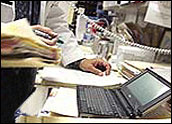
It should come as no surprise that Maurice Ramirez — an emergency room attending physician with Florida Hospital’s Flagler division — is in favor of widespread adoption of automated personal health records, or PHRs.
Ramirez was once chief medical officer for a company that was developing such an application, but that’s not his only reference point. He has also been on the ground in the wake of many disasters, including the aftermath of Hurricane Ike, which struck Galveston, Texas, last year.
A PHR can be invaluable to both those needing help — who may be too traumatized to give an accurate medical history — and their rescuers. Ramirez carries his own PHR in an RFID chip implanted in his arm. He wears dog tags to direct any medical personnel who might wind up attending him to the chip.
“I’ve never had a significant injury while in the field, but we have used readers on other people,” he told CRM Buyer. “They are an invaluable tool — no matter what format they come in.”
Many Forms, Same Content
A number of disparate models have sprung up around the PHR concept. The most common are Web-based applications that consumers or doctors update with the latest information regarding prescriptions, test results and so on. Another model focuses on records that are physically portable, such as an RFID chip or a USB drive.
For all their worth — and there are a number of good reasons to use a PHR — adoption has been low, because neither physicians nor consumers have been aggressive in implementing — or even asking for — such applications.
“The numbers are tiny at best,” Carla Smith, executive vice president of the Healthcare Information and Management Systems Society, told CRM Buyer.
However, PHRs may soon receive a boost from the federal government. President Barack Obama has made promises to reform the U.S. health insurance system, both on the campaign trail and since he assumed office. One of the main tenets underlying his approach to covering the tens of millions of Americans who are uninsured is that costs can be streamlined through the use of technology. What role will PHRs play? Technically, none. What will be addressed, though, will be the use of electronic medical records.
Federal Boost
Electronic medical records, or EMRs, are a variation on the PHR theme, Smith explained.
They are centralized records that some hospitals, insurance companies and pharmacies are beginning to maintain in order to keep track of the care their patients or customers receive. Last summer, the two largest electronic prescription networks — RxHub and SureScripts — decided to merge into one integrated system.
Unfortunately the twain — PHRs, that is, and the EMRs that are slowly being assembled — have yet to meet, Smith said. “There are some synergies between the two groups right now — but not much.”
A funding provision in the stimulus bill working its way to the president’s desk would provide a huge boost for the use of electronic medical records in the U.S., said Smith.
“President Obama has a goal of having all Americans participate in this technology within the next five years,” she noted.
With that piece in place, the final link to the consumer — the front end, so to speak, of this nationwide electronic medical apparatus — will begin to build out.
The patient’s participation in the system — the personal health record — is definitely the missing piece right now, physician Viriginia Cardin, a senior healthcare consultant at research firm Frost & Sullivan, told CRM Buyer.
“A lot of the background work is already in place — hospital networks and regional groups that have come together and are already linked,” she noted. “Now we need the individual physicians and their patients to move forward.”
The Road Ahead
What the medical industry is hoping is that as the stimulus drives more investment in the back end — that is, EMR systems — more private sector companies will be willing to invest in the PHRs in the front end. Certainly, demand for these applications will rise as more consumers see what they can do.
Ramirez, for one, expects that as early as 2014, a new patient’s medical history will reach the doctor’s office prior to the first appointment.
Insurance companies will issue smart cards — “basically, PHRs that contain all of your records and can be updated when you leave the doctor’s office,” he predicts. Besides keeping records for the patient, the cards could serve as a backup in the event of a system-wide crash.
At least one element that Ramirez envisions has been in limited use for several years byUnited Healthcare.
Recently, it began offering the cards in formats that could be used with standard readers in order to encourage more adoption, Christopher Stanley, a regional medical director for the carrier, told CRM Buyer. The older models were larger and more expensive for doctors.
Swipe cards will be key in the next wave of healthcare technology adoption, predicted Stanley. “We are going to see a continued expansion in the rollout of medical health records — and a significant leap in the connectivity between these standalone records and the larger medical and healthcare community.”












































Social CRM
See all Social CRM